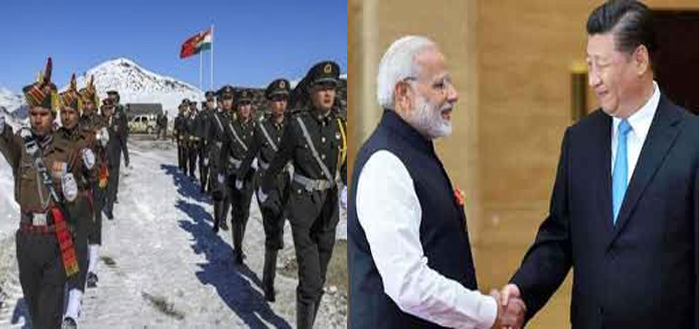The China-India relationship has been strained for over four years, centered on a military standoff in eastern Ladakh. Tensions have escalated around the Line of Actual Control (LAC), with both countries maintaining heavy troop deployments across contested territories, particularly in Demchok and Depsang. However, recent developments suggest that there is hope on the horizon as China and India agree to continue diplomatic and military-level negotiations to bring the situation to a peaceful resolution.
Diplomatic Channels and Strategic Dialogues
China’s Defense Ministry spokesman, Zhang Xiaogang, has revealed that both countries are committed to further discussions. These talks aim to dismantle the deadlock, reduce friction at the border, and establish a more stable and peaceful relationship in the region. Diplomatic and military channels remain open, with both countries actively engaging in constructive dialogue. This includes meetings between high-level officials, such as India’s External Affairs Minister S. Jaishankar and Chinese Foreign Minister Wang Yi, as well as the National Security Advisor Ajit Doval.
These diplomatic efforts are reinforced through a border consultation mechanism, which serves as a platform for ensuring ongoing communication between the two nations. This mechanism underscores the importance of consistent dialogue and transparency in de-escalating the conflict.
Consensus on Strengthening Dialogue
Through these talks, China and India have managed to reach certain points of consensus. Both sides have expressed a willingness to strengthen dialogue and reduce their differences by accommodating each other’s legitimate concerns. According to Zhang, the goal is to arrive at a solution that is both mutually acceptable and sustainable, ensuring peace and stability along the border. Both nations appear committed to maintaining ongoing negotiations until they can find common ground and resolve their disputes in eastern Ladakh.
The Galwan Valley incident in 2020 served as a critical flashpoint in Sino-Indian relations. However, Zhang’s recent comments suggest that both countries are now determined to prevent further escalations and consolidate their peace-building efforts. This is a pivotal development in the de-escalation process, as it indicates that despite the challenges, China and India are willing to work together towards a stable and lasting peace.
The Path to Disengagement
One of the core issues in the India-China standoff has been the disengagement of troops from several friction points along the LAC. Although there has been progress in some areas, particularly in the Galwan Valley, where troops have withdrawn, other regions such as Demchok and Depsang remain contentious.
During recent discussions, Zhang refrained from commenting on the specific progress of disengagement in these two key areas. However, he emphasized that both countries are committed to consolidating the results already achieved and continuing the momentum towards full disengagement. It’s clear that disengagement remains a top priority for both China and India, and both sides appear to be working diligently to achieve a comprehensive resolution.
The Role of High-Level Meetings
High-level meetings between China and India have played a crucial role in advancing the peace process. In particular, the recent meeting between Wang Yi and Ajit Doval on the sidelines of the BRICS summit in Russia has been instrumental in moving the dialogue forward. These talks highlighted the shared commitment of both nations to reducing tensions and finding diplomatic solutions.
Chinese Foreign Ministry spokesperson Mao Ning remarked that the frontline troops of both countries had already withdrawn from four areas along the western sector of the China-India border. This includes significant progress in the Galwan Valley, a region that has seen some of the most intense skirmishes during the standoff.
The fact that high-level officials are involved in the negotiations underscores the importance of the issue and the mutual desire to resolve it. These meetings serve not only as opportunities for dialogue but also as signals to the international community that both China and India are taking proactive steps to address the situation in a responsible manner.
A History of Bilateral Agreements
India’s External Affairs Minister S. Jaishankar has pointed out that both nations have a series of bilateral agreements in place to maintain peace and stability along the LAC. These agreements provide a framework for conflict resolution and are intended to guide both countries in their efforts to reduce tensions. However, Jaishankar also noted that these agreements were violated during the 2020 escalation, when China moved a large number of troops to the LAC, despite the ongoing COVID-19 pandemic.
India responded in kind, deploying its own forces to the region to match the Chinese buildup. This move, according to Jaishankar, was necessary to protect India’s territorial integrity and uphold the agreements that were in place.
Despite these setbacks, the existence of such agreements remains crucial for the current negotiations. Both sides have acknowledged their importance and have pledged to respect bilateral commitments and work towards building greater mutual trust along the border.
Building Confidence for Future Peace
The ongoing dialogue between China and India highlights the importance of confidence-building measures. Both sides are focused on consolidating the results of previous agreements and ensuring that future negotiations remain constructive. Zhang emphasized that China and India are committed to respecting mutual confidence-building measures, which are key to maintaining peace and preventing future escalations along the LAC.
For both countries, the goal is to strengthen trust, ensure transparency, and avoid misunderstandings that could lead to future conflict. As the situation evolves, it will be critical for both nations to continue engaging in meaningful dialogue and taking proactive steps to reduce tensions and build long-term peace.
Conclusion: A Step Towards Stability
While the military standoff between China and India in eastern Ladakh has been ongoing for more than four years, the recent agreement to continue talks signals a significant step towards peace. Both nations are actively working to de-escalate tensions, engage in constructive dialogue, and find mutually acceptable solutions to their disputes.
Through diplomatic channels, high-level meetings, and ongoing negotiations, both China and India have demonstrated their commitment to resolving the situation peacefully. While challenges remain, especially in Demchok and Depsang, the progress made so far provides hope that a long-term resolution is possible.
Moving forward, the focus will be on maintaining the momentum of these talks, ensuring that bilateral agreements are respected, and building mutual trust to prevent future conflicts. By continuing to engage in confidence-building measures and constructive dialogue, both China and India have the potential to pave the way for a more stable and peaceful future along their shared border.
















